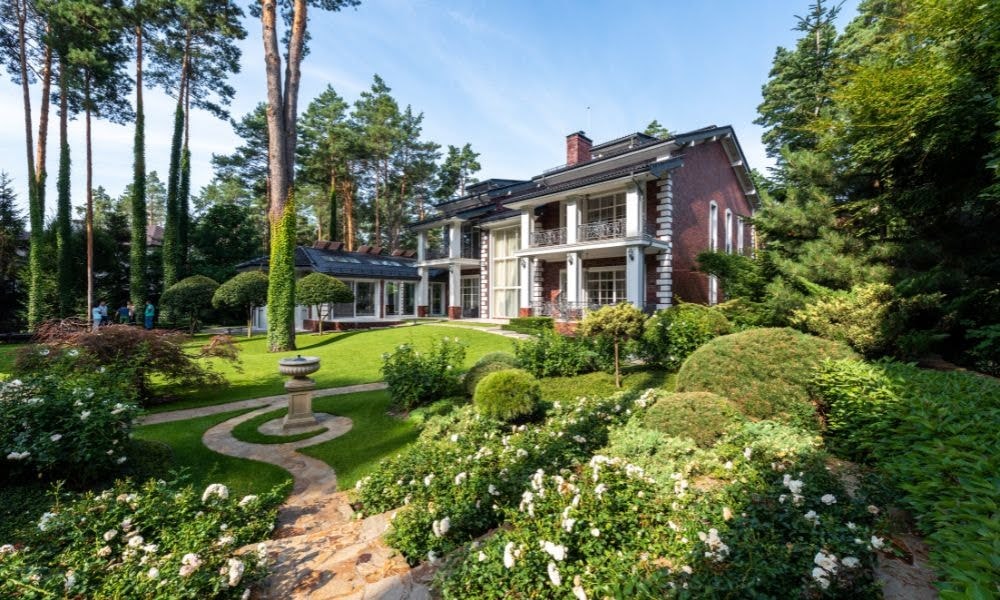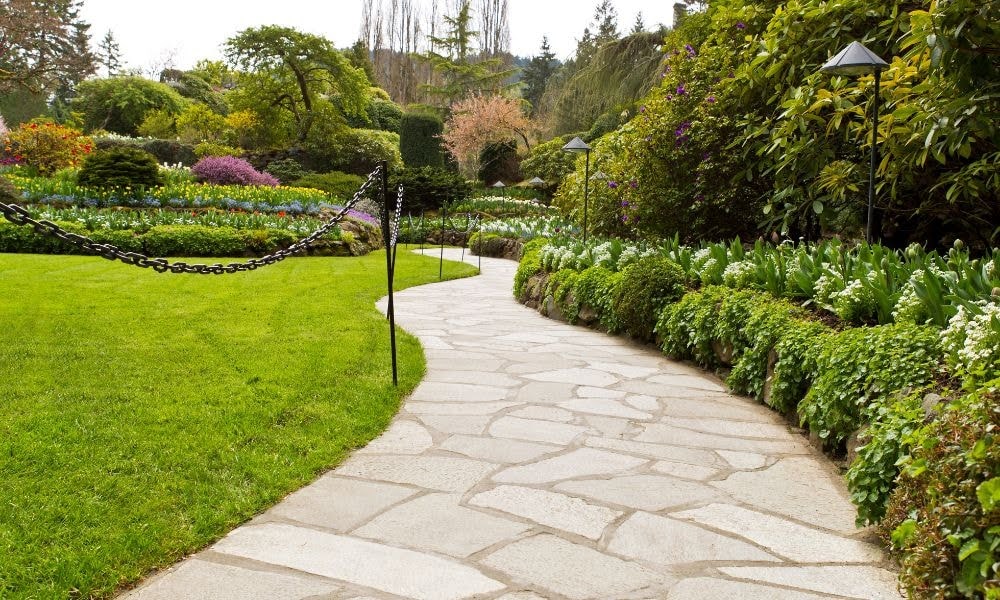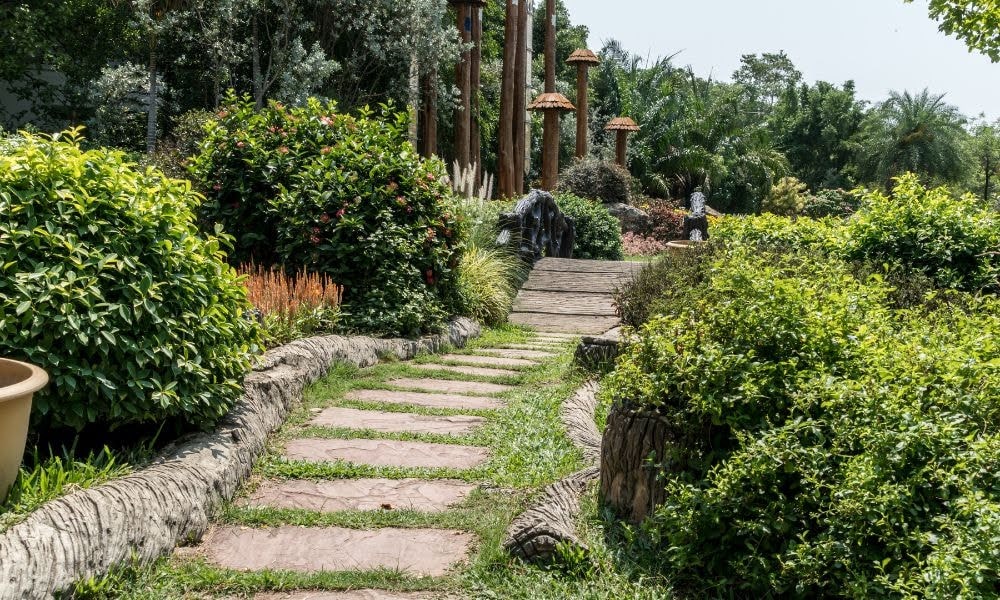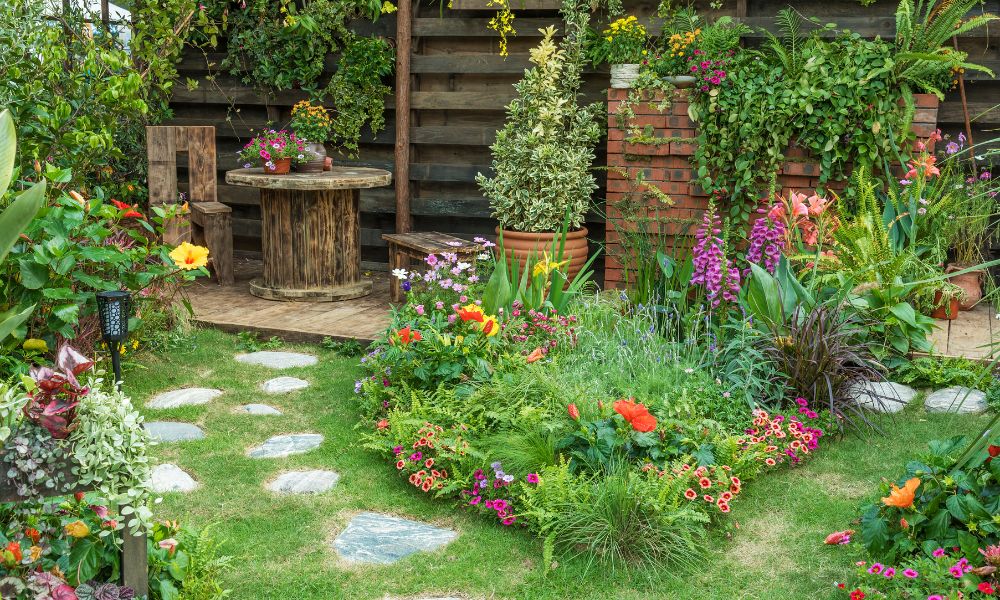Garden pathways do more than just connect different areas of your outdoor space—they set the tone for your entire garden’s layout. Whether you’re looking for creative garden pathway designs or simply want to upgrade an existing garden path, pathways are essential in balancing both beauty and practicality. They guide visitors through the garden, creating a natural flow while ensuring ease of movement and navigation.
Well-designed garden path ideas can enhance your outdoor space’s overall appeal by blending form and function. The right path complements the garden’s style and provides safe, accessible routes for everyone to enjoy. Whether formal or informal, the goal is to balance functionality and aesthetics.
Importance of Garden Pathways
Garden paths improve navigation, making it easy to move through your garden without disturbing plants while also creating a natural focal point that enhances the overall design. They add structure and flow, guiding visitors and dividing spaces visually. Well-designed paths also increase safety and accessibility, ensuring smooth movement for everyone, whether walking through a beautiful garden or using a lawn mower. Working with a landscape designer ensures your pathways offer function and style.
Types of Garden Pathways
Garden pathways come in a variety of styles, each serving a specific purpose and adding unique character to your outdoor space.
Primary pathways: These are the main routes in your garden, often located in high-traffic areas. They connect key spaces like the patio, entrance, and garden beds are typically made from durable materials such as stone or brick garden paths to withstand regular use.
Secondary pathways: These paths serve a more decorative role and are both functional and visually appealing. They can lead to specific garden features or areas while using creative materials like DIY garden path options, adding charm to your design.
Informal pathways: For a more rustic, natural look, informal paths offer an organic flow through the garden. These are often made from gravel, mulch, or stepping stones and provide a relaxed, meandering route perfect for casual strolls.
Elevate Your Outdoor Space with Wellspring
Materials for Garden Pathways
The materials you choose for your garden pathways significantly impact your outdoor space’s look and function. Each option has its own unique benefits, allowing you to create a pathway that complements your garden’s style and meets your practical needs.
- Natural stone: Known for its timeless elegance and durability, stone paths provide a sophisticated, long-lasting option that works well in most garden settings.
- Brick: Offering classic charm and texture, brick garden paths add a traditional touch and are ideal for creating a warm, welcoming feel in your garden.
- Gravel: A budget-friendly and versatile material, gravel is perfect for informal or diy garden path projects. It’s easy to install and provides excellent drainage.
- Pavers: With flexible design options, pavers allow for creativity in patterns and layouts, making them a great choice for custom pathway designs.
- Wood: For a rustic and natural appeal, wooden pathways blend seamlessly with the surrounding landscape, offering a relaxed and organic feel.
- Concrete: Modern and sleek concrete pathways are durable and low-maintenance, making them an ideal option for a contemporary garden design.
Combining Pathway Materials
Combining different materials in garden pathways can add visual interest and contrast, creating a unique design that stands out. For example, mixing a stone path with gravel can provide texture and depth, while pairing brick with wood brings warmth and a natural feel to the space.
You can also create borders using contrasting materials, such as stone or brick, to define the edges of a straight path or to frame potted plants and climbing plants, enhancing both structure and beauty within your garden.
Pathway Shapes and Layouts
The shape and layout of your garden pathways can dramatically impact the overall vibe of your outdoor space. Straight pathways give a formal, clean appearance, while curved pathways offer a more organic, inviting flow. For a more leisurely experience, meandering pathways encourage exploration, allowing you to enjoy different parts of the garden at a relaxed pace. Circular designs create striking focal points, perfect for framing key garden features or central areas.
Design Considerations for Pathway Width
When designing garden pathways, the width plays a key role in the overall look and function. Narrow paths are ideal for creating intimate spaces and guiding visitors through cozy, tucked-away areas of the garden.
In contrast, wide paths work well for grand entryways, making a bold, welcoming statement. It’s important to maintain a proportional design based on the size of your garden, ensuring the pathway fits harmoniously within the overall landscape.
Pathway Edging Techniques
Edging techniques can greatly enhance the look of your garden pathways. Raised edging provides a defined, clean appearance that clearly separates the path from the surrounding garden. For a more seamless and subtle effect, flush edging allows the pathway to blend smoothly with the landscape. Alternatively, you can use plants as natural borders, incorporating greenery to soften the edges and create a more organic feel.
Pathway Illumination Ideas
Lighting your garden path can enhance both its functionality and ambiance. Solar lights are an eco-friendly, low-maintenance option that provides soft illumination without adding to your energy bill. For a modern, sleek touch, LED strip lighting can be installed along the path’s edges, creating a clean aesthetic.
If you’re aiming for a more traditional feel, lanterns offer a warm and inviting glow. For those who prefer minimalism, recessed ground lights provide subtle lighting while keeping the focus on the pathway itself.
Planting Along Pathways
Incorporating plants along your garden pathways adds beauty and functionality. Low-growing plants make excellent borders, defining the path while keeping a neat, trimmed look. Groundcovers are perfect for softening the edges, creating a seamless transition between the pathway and the rest of the garden.
Adding ornamental grasses introduces movement and texture, making the pathway feel more dynamic and lively as the plants sway gently in the breeze.
Creating Focal Points Along Pathways
Creating focal points along your garden pathways enhances visual interest and draws attention to key areas. You can achieve this by adding statues or sculptures as artistic highlights. Water features make excellent destination points, providing both movement and sound to engage the senses. Additionally, installing arches or pergolas adds architectural interest, creating a grand entrance or framing specific garden parts.
Functional Pathways for Garden Accessibility
Designing functional pathways with accessibility ensures everyone can enjoy your garden. Wheelchair-accessible pathways should be wide, smooth, and free of obstacles, allowing easy navigation. Adding handrails along paths provides extra support for those who need it, improving safety and comfort. Using slip-resistant surfaces helps prevent accidents, particularly in wet conditions, making the garden safe for all visitors.
Integrating Pathways with Hardscapes
Integrating pathways with hardscapes creates seamless connections between key outdoor areas. Pathways can link patios to seating areas, guide visitors to outdoor kitchens or fire pits, and connect with decks and pergolas, ensuring a cohesive and functional outdoor space.
Seasonal Considerations for Pathway Design
Choose materials that suit your local climate for seasonal considerations in pathway design. In wet areas, use pathways that perform well in moisture-rich environments. For cold regions, select frost-resistant materials to prevent damage during freezing temperatures, while heat-reflective materials are ideal for hot climates to keep pathways cool and comfortable.
Water-Permeable Pathways for Sustainable Gardens
Water-permeable pathways are a great solution for sustainable gardens, naturally allowing water to drain through materials like gravel or permeable pavers. These pathways help reduce water runoff, preventing erosion and water pooling, which can damage your garden. You can also integrate rain gardens along pathways to improve water management, using plants to absorb excess water and filter pollutants.
Achieve a Healthy Lawn with Wellspring’s Expertise
Pathways as Wildlife Corridors
Wildlife corridors, such as pathways, can enhance biodiversity by attracting beneficial creatures like pollinators. By incorporating native plants into your paths, you create an environment that supports local wildlife, providing them with food and shelter. Features like nesting boxes and water sources along the pathways encourage diverse species to thrive, transforming your garden into a habitat-friendly space.
Using Pathways to Divide Garden Zones
Using pathways to divide garden zones helps create a well-organized and functional outdoor space. Pathways can be used to separate planting areas, making distinguishing between different garden beds or plant types easy. They can also define distinct sections for relaxation and activity, such as separating a play area from a quiet seating zone. Pathways can lead to hidden garden nooks, offering secluded spots for privacy and contemplation.
Creative Pathway Accents
For a unique touch, creative pathway accents can elevate the design of your garden. Consider using mosaics or tile inlays to add color and artistic patterns to your paths. Embedding glow-in-the-dark stones provides gentle illumination at night, creating a magical atmosphere. For a personal touch, you can add stepping stones with engravings featuring names, dates, or meaningful messages that make your pathway truly one-of-a-kind.
DIY vs Professional Pathway Installation
When considering DIY vs professional pathway installation, both approaches have their advantages. DIY pathway projects can be cost-effective and provide a sense of accomplishment, especially for simple designs like gravel or stepping-stone paths.
However, hiring professionals ensures proper installation and durability for more complex designs involving intricate patterns or materials like stone or brick. It’s also important to weigh cost considerations, as DIY can save on labor but may require more time and effort. In contrast, professionals can handle the job efficiently, albeit at a higher price.
Maintaining Garden Pathways
Maintaining garden pathways is essential for keeping them in good condition. Regular cleaning depends on the material; stone paths may need occasional power washing, while gravel requires raking. Preventing weeds between pavers or stones can be done by using weed barrier fabric or natural weed killers. Sealing and waterproofing pathways, especially those made from wood or concrete, help protect them from weather damage and extend their lifespan.
Pathway Design Mistakes to Avoid
When designing garden pathways, certain mistakes can reduce your outdoor space’s functionality and appearance. Ignoring the garden layout and functionality may result in pathways that don’t suit the flow or practical needs of the garden, making navigation awkward.
Also, choosing inappropriate materials for the climate can cause pathways to degrade faster; for example, some stones may crack in freezing conditions or become too hot in sunny areas. Lastly, overcrowding pathways with plants or accents can create a cluttered feel, limiting usability and diminishing the overall aesthetic.
Making Your Garden Pathways Useful and Beautiful
Designing garden pathways is all about finding the right balance between function and beauty. Whether you’re creating a straight path for easy access or adding curves for a more relaxed feel, pathways should serve both practical needs and enhance the overall look of your garden. Remember, the materials and layout you choose will impact how your garden is used and how it feels.
Don’t be afraid to get creative and make your pathways reflect your personal style. Whether you use unique materials, add accents, or design hidden nooks, your garden pathways can be both functional and beautiful. The key is to design with purpose, ensuring that each path enhances the flow and character of your outdoor space.






